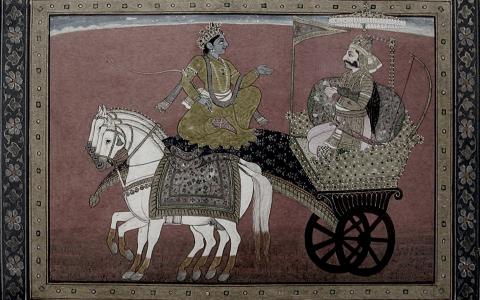November 2016

इत्यर्थ-क्वथितं चैवा-प्येतिभावाख्य-तेमनम् ।सज्जीकृते सुभुक्त्यर्थंतुष्यताद्भवदाशयः ॥
We have seen that Mallinatha, lost in his scholarly activities, didn’t spend quality time with his wife. Studying difficult works of shastra was his favourite pastime. This was, in a way, not unreasonable: In order to write commentaries on the works of prodigious scholar-poets like Kalidasa, Bharavi, Magha and Sriharsha, ordinary scholarship is insufficient. The...

The Western tradition uses the word ‘philosophy’ (love of wisdom) to denote the study of the fundamental nature of reality. In the Indian tradition, we use the word ‘darshana’ (point of view) to denote the study of existence, meaning, consciousness, and the ultimate reality. It provides us the means to the same ultimate goal, called by different names – ananda (bliss); moksha (liberation); or oneness with brahman, the Supreme Being.
What we now...

Evolution of Raaga
Raagas have changed and even transformed with respect to the definition given by Bharatamuni. Of course, it is only natural for perspective of arts to change with times. The most ancient forms of music that we can trace goes back to the Vedas. We can experience the early forms in folk, tribal music as well as in some theatrical music such as in yakshagaana or sopaanam. Apart from this, musicologists like Shrangadeva,...

“Who am I?”
This question has haunted thinkers and philosophers from the earliest times. It is the question that drove the sixteen-year-old Venkataraman to eventually become Ramana Maharishi. It is the question that pops up every now and then, only to remain unanswered. Once it is answered, the question never recurs, for one would have transcended all questions by answering that one.
So, who are we?
From our high school biology we know that when...

तिन्त्रिणीदलसमानलोचनेदेवदुन्दुभिसमानमध्यमे ।अर्कशुष्कफलव्ध्वनस्तनिरामवैरिभगिनीव राजसे ॥
Mallinatha was a great commentator. His felicity in capturing the crux of a poem and explaining its finer aspects is extraordinary. He wrote glosses on Magha’s Shishupalavadha and Kalidasa’s Meghadutam – Sarvankasha and Sanjivini respectively – and exclaimed माघे मेघे गतं वयः (I’ve read Shishupalavadha and Meghadutam. What else do I need in life? )
He used to...

Kosambi launches into a polemic against Krishna, considering him as a real person, forgetting that he himself had cast doubts on the existence of Krishna in the first place. Kosambi spews venom against the acharya of the Gita (emphasis is mine):
“...Krsna as he appears in the Mbh is singularly ill-suited to propound any really moral doctrine. The most venerable character of the epic, Bhisma, takes up the greatest of Mbh parvans (Santi) with...

The Geeta exposition is essentially contained between the words 'अशोच्यान्' (BG 2.11) and 'मा शुच:' (BG 18.66). The central message is quite simply ‘grieve not’; for what really is, is of the nature of pure joy ("नासतो विद्यते भावो नाभावो विद्यते सत:"). How not to grieve is what Krishna seeks to explain.
The long and short of that explanation is to be found in his classification of joys into the satvic, rajasic and tamasic types (Chapter 18). A...

It is usually thought in the world of classical arts, especially in the Carnatic circles in India that a prodigy is born in a family which is rich with a music tradition, and in most cases, belonging to the lineage of one of the stalwarts. It is rather rare to find a genius being born in an unconnected atmosphere. When the eight-holed bamboo flute was still trying to figure out its place in main stream Carnatic music as a solo and an...

किं वाससा चीकरिबाकिरेणकिं दारुणा वङ्कर-टिङ्करेण ।सर्वज्ञभूपालविलोकनार्थंवैदुष्यमेको विदुषां सहायः ॥
Mahamahopadhyaya Mallinatha Suri, the celebrated scholar, wrote commentaries on important Sanskrit kavyas. His explanation of the five epic-poems and Kalidasa’s Meghadutam are good testimonies of his scholarship. He was also a gifted poet. Raghuviracharitam and Udarakavya are his independent works. Following the footsteps of his grandfather,...

Of late, echoes of a certain something called "Art Therapy" has been resonating throughout our land. More specifically, there has been an increase in the number of self-proclaimed "Art Therapists" strutting around with claims that they can cure a wide variety of diseases using music, dance, painting and poetry. They occupy the line already populated by that class of people who've anointed themselves as Sanyasis-Babas and Gurujis. Not just this--...
